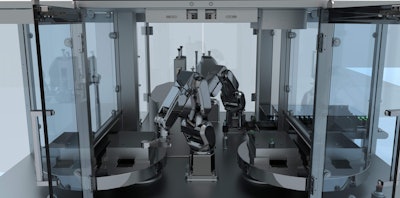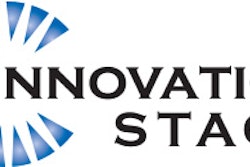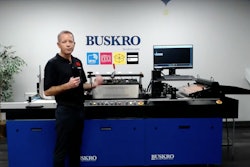
This Stevanato Group automated visual inspection system—the Vision Robot Unit, or VRU—is designed for accurate and flexible inspection of vials, syringes, cartridges, and more. On display at PACK EXPO Connects, one machine accommodates a range of products including monoclonal antibodies (mAbs), vaccines and lyophilized drugs. The system, which is being delivered to its first customer toward the beginning of 2021, inspects both cosmetic and particle properties without human intervention.
With the recent growth of cell therapies, biopharmaceutical companies are in need of flexible machines with fast changeover for small, high-value batches.
Giacomo Girotto, vision inspection project manager at Stevanato Group, says, “We want to release the full flexibility of human-like inspection, together with the repeatability and scalability of automated inspection equipment. The system allows some of the flexibility of a ‘human-like inspection’ including the capability to rotate and tilt the containers as they are being inspected, allowing for new inspection possibilities.”
With standard vision inspection machines, there may be different format parts to accommodate an array of products, but with the VRU, the robotic gripper means the setup time passing from one format to another is greatly reduced. Its no glass-to-glass inspection process significantly mitigates the likelihood of product damage or breakage for fragile containers.
One machine: multiple products
Flexibility is a key benefit of the machine. Whether the end user is a brand owner or contract manufacturer, they are likely to be processing very small batches (some thousands per year) or personalized batches based on a patient’s own cells, where a product may have different attributes—such as varying viscosity—depending on the patient and treatment.
This is where AI technology comes in; the VRU is able to improve its inspection performance as data is collected. The unit can quickly react to changing product characteristics—including active ingredient variations, differing fill levels, and different containers—even throughout a single batch.
It is also adaptive, exhibiting continuous learning from both production and operator stimuli. It learns to look at the necessary part of the image and isolate the defect. The result is an improvement in the reduction in both costly false rejects and, even more importantly, false positives. In one trial focusing on reducing the False Rejection Rate (FRR) due to bubbles misclassified as particles, the inspection system viewed 30,000 product images and the false reject rate dropped to 0.21%.
[For more, check out AI Deep Learning in the Pharma Market.]
Scalable system
The VRU’s island design, for which there is a patent pending, comprises a versatile “plug & play” concept with a freely configurable infeed and outfeed. It is also scalable, so multiple vision inspection units can be added to increase throughput as needs dictate.
To view demos in their entirety (available through March 31, 2021) and add Stevanato Group to your MyConnects Planner, click here.

![Cng D Main Navy Blue[4]](https://img.packworld.com/files/base/pmmi/all/image/2020/11/CNG_D_Main_Navy_Blue_4_.5fad4e9934ec7.png?auto=format%2Ccompress&bg=fff&fill-color=fff&fit=fill&h=167&pad=5&q=70&w=250)



















